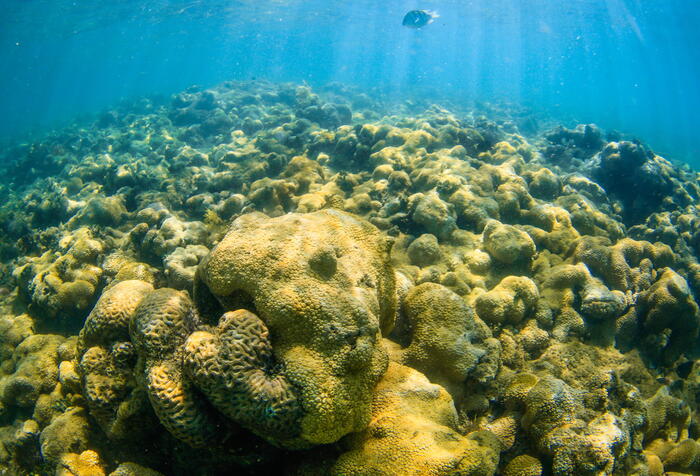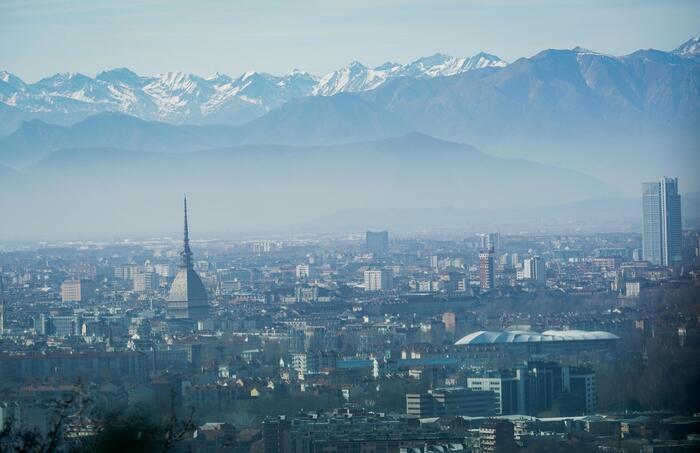Icon: enlarge
Map of Europe with the evaluated fine dust values for the current winter
Photo: DER SPIEGEL / EEA
Actually, Adam Niedzielski's announcement should be a gift.
Despite the prolonged shutdown, the Polish health minister announced that children should be able to play outdoors again undisturbed, without parental supervision.
"We are in the holiday season and unfortunately it is not like usual. Nevertheless, children should be able to enjoy the fresh air from 8 a.m. to 4 p.m.," said the conservative politician in Warsaw a few days ago.
However, many Poles commented on the announcement with derision on the Internet.
Not without reason: While Niedzielski was talking about fresh air, his country stood out with the highest figures for smog in Europe.
On the real-time map of the European Environment Agency EEA, the entire south of the country currently often appears like a dark, dense patchwork quilt.
In no other country in Europe do so many measuring points light up dark red as often as in Poland.
Translated this means: According to official measurements, the air quality measured hourly was either “bad”, “very bad” or “extremely bad”.
Across the EU, it is worse than here in only a few regions, with significantly more people living in Poland than in all other countries in Central and Eastern Europe.
A SPIEGEL analysis shows where particularly high particulate matter levels are currently being measured and what the levels looked like last year:
The values are snapshots, compiled from 7,779,988 real-time values that were transmitted to the EU and evaluated by SPIEGEL.
The data were first offset against daily mean values and then adjusted for incomplete results and the figures for New Year's Eve.
These are the latest results from more than 1000 measuring stations across Europe.
How and where the air quality is measured varies considerably in some cases.
In some regions, little data has been transmitted so far.
Later weightings can change the picture - it is not for nothing that the EEA does not publish its validated annual report until a year and a half later.
But the current measured values already show more than clearly that the air in many regions is currently particularly hazardous to health.
Particulate matter is a particular danger in winter.
The cold weather not only ensures that there is more heating, but also that the toxic fog stays on the ground longer than at other times of the year.
A dangerous mix.
Icon: enlarge
Since the beginning of the pandemic, wearing mouth and nose protection has also been mandatory in Poland's buses and trains.
However, some citizens wore it before - because of air pollution
Photo: Omar Marques / imago images / ZUMA Wire
The World Health Organization (WHO) has long recommended a limit value of ten micrograms per cubic meter of air as an annual mean for fine dust of the size PM2.5 - many regions in Europe are far from this value.
Even the much lighter EU limit of 25 micrograms is not yet complied with in a number of cities.
In the SPIEGEL evaluation for 2020, according to the reported values, more than 480 stations were above the WHO reference value.
A clear sign that the air quality is still poor.
It is no coincidence that particularly high values often come from Poland: Millions of households here still heat with wood and cheap coal.
In quite a few apartments there is also household waste and plastic waste.
Toxic smoke often ends up in the air more or less unfiltered.
In other regions such as Italy's industrial north, too, the air quality is often poor.
But in hardly any other region it is the residents themselves who, with old ovens and stoves, have such a negative impact on their surroundings as in southern Poland.
Scientists fear additional risk in the corona crisis
Over the past few weeks, television has shown again and again what this means in many people's everyday lives: Krakow currently seems to be sinking into gray-white smog.
On the day the government published its fresh air appeal, Krakow was one of the ten cities with the highest levels of air pollution in the world according to the unofficial ranking by the Swiss company IQ Air.
A single value - which nevertheless fits well into the picture that many Poles have of the second largest city in their country.
Icon: enlarge
Scene in a ward of a hospital in Wroclaw that specializes in corona patients: Patients with respiratory diseases often experience particularly severe courses of infection
Photo: Marek M Berezowski / REPORTER / imago images / Eastnews
The so-called PM2.5 particles are primarily a health risk because they are so small.
Less than 2.5 micrometers in diameter, they are around 20 to 40 times as small as a human hair.
Because of this size, they easily get into the body, where they can damage the lungs in particular.
During the corona pandemic, initial studies from the USA show, this can be life-threatening: "In regions with poor air quality, more Sars-CoV-2 infected people will be hospitalized and more will die," the head of one predicted last year Harvard study.
The second wave of the corona pandemic is currently hitting Poland hard.
More than 30,000 people have died, and many hospitals lack the doctors who have emigrated in recent years.
In many places, the staff has been working at the limit for weeks.
Poland is not the only European country where there is currently a particular danger in the air.
In Bulgaria and the Balkans, too, old worries
Coal stoves and unfiltered chimneys ensure that a particularly large amount of fine dust enters the environment every winter.
See here how the measured fine dust pollution changes over the course of a year:
According to EU estimates, around 45,000 people died prematurely every year in Poland in the recent past as a result of air pollution - more than previously as a result of the corona pandemic.
It is similar in other countries.
According to the EEA, a large part of this is due to fine dust.
The fact that the air in hardly any other EU country is dirtier is largely due to Poland's obsession with coal.
Three quarters of the electricity was still produced with fossil fuel in 2019, three times more than in Germany and more than anywhere else in the EU.
Icon: enlarge
The official WHO guideline value of ten micrograms of fine dust per cubic meter (PM2.5) has been exceeded in many European locations for years.
But even the much lighter EU limit value is often not complied with in Poland
Photo: Omar Marques / imago images / ZUMA Wire
At the European level, the government has been delaying stricter rules for years, and the last coal mine is not due to close until 2049.
The consequences of this environmental policy can be felt in everyday life.
"We can often taste the poisonous air," complains environmental activist Magdalena Kozlowska from Krakow.
"It tastes bitter and dry."
The south of the country is the historical center of Polish coal mining.
Those who live there theoretically smoke several thousand cigarettes a year - just by breathing in the air.
"Long before Corona, I had an air filter in my apartment and a mouth and nose cover in my pocket," reports the 33-year-old.
There have long been attempts to improve air quality.
One and a half years ago, Krakow was the first Polish city to completely ban wood and coal heating.
The move was largely driven by the Krakow Alarm Smogowy group, a broad alliance to which Magdalena Kozlowska also belongs.
The initiative is now also active in other cities, and there are now 39 local branches nationwide.
After a transitional period of several years with modernization bonuses, violations are now threatened with fines.
Since then, the city has also been using drones to monitor whether smoke is still coming out of the chimneys.
The mood among the urban population has also changed in recent years.
The exit from coal is now a majority, and in surveys many Poles are now in favor of stricter laws and a faster exit.
Away from the big city, the air is still full of soot
But in the area around Krakow, despite all the reforms, heating has mostly continued unchanged so far.
If the wind is unfavorable, the smell of coal from the suburbs is still in the air.
In many small towns there is no pressure to switch off the old ovens for good, complains Magdalena Kozlowska.
Many politicians looked the other way.
The coal in southern Poland creates jobs and supplies the rest of the country with energy.
Not least because of this, it is considered a national symbol, which is still defiantly defended here.
Shortly before the second shutdown, the Alarm Smogowy activists drove through villages and small towns around Krakow under the motto "See what you breathe".
In their luggage they had a trailer with a two-meter white lung.
It didn't take long before it was black.
Icon: The mirror
This contribution is part of the Global Society project
What is the Global Society project? Up arrow Down arrow
Under the title Global Society, reporters from
Asia, Africa, Latin America and Europe
report on injustices in a globalized world, socio-political challenges and sustainable development.
The reports, analyzes, photo series, videos and podcasts appear in the international section of SPIEGEL.
The project is long-term and will be supported by the Bill & Melinda Gates Foundation (BMGF) for three years.
A detailed FAQ with questions and answers about the project can be found here.
What does the funding look like in concrete terms? Up arrow Down arrow
The Bill & Melinda Gates Foundation (BMGF) is supporting the project for three years with a total of around 2.3 million euros.
Is the journalistic content independent of the foundation? Up arrow Down arrow
Yes.
The editorial content is created without any influence from the Gates Foundation.
Do other media have similar projects? Up arrow Down arrow
Yes.
Major European media outlets such as "The Guardian" and "El País" have set up similar sections on their news pages with "Global Development" and "Planeta Futuro" with the support of the Gates Foundation.
Have there already been similar projects at SPIEGEL? Up arrow Down arrow
In recent years, SPIEGEL has already implemented two projects with the European Journalism Center (EJC) and the support of the Bill & Melinda Gates Foundation: The "Expedition The Day After Tomorrow" on global sustainability goals and the journalistic refugee project "The New Arrivals", as part of this several award-winning multimedia reports on the topics of migration and flight have emerged.
Where can I find all publications on Global Society? Up arrow Down arrow
The pieces can be found at SPIEGEL on the topic Global Society.













